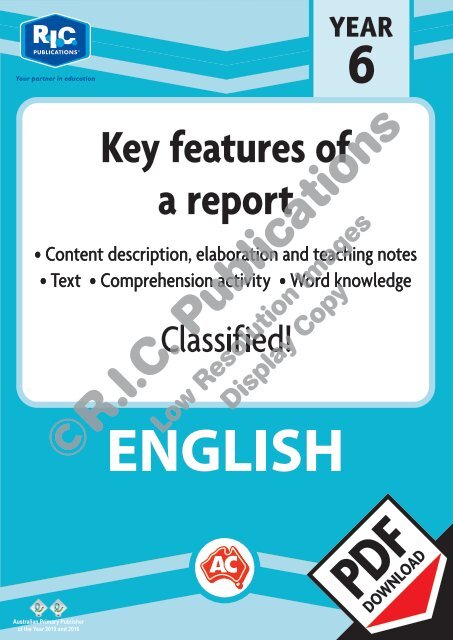30109 Classified - Key features of a report
Create successful ePaper yourself
Turn your PDF publications into a flip-book with our unique Google optimized e-Paper software.
©R.I.C. Publications<br />
Low Resolution Images<br />
Display Copy
<strong>Classified</strong>!<br />
Teacher information<br />
Text<br />
Curriculum links<br />
Activity Content description Elaboration<br />
Comprehension<br />
Word knowledge<br />
Additional teacher<br />
information<br />
• Identify and explain how analytical images like figures,<br />
tables, diagrams, maps and graphs contribute to our<br />
understanding <strong>of</strong> verbal information in factual and<br />
persuasive texts (ACELA1524)<br />
• Analyse how text structures and language <strong>features</strong> work<br />
together to meet the purpose <strong>of</strong> a text (ACELY1711)<br />
• Analyse and evaluate similarities and differences in texts on<br />
similar topics, themes or plots (ACELT1614)<br />
• Use comprehension strategies to interpret and analyse<br />
information and ideas, comparing content from a variety <strong>of</strong><br />
textual sources including media and digital texts<br />
(ACELY1713)<br />
• Investigate how vocabulary choices, including evaluative<br />
language can express shades <strong>of</strong> meaning, feeling and<br />
opinion (ACELA1525)<br />
• Understand how to use knowledge <strong>of</strong> known words, word<br />
origins including some Latin and Greek roots, base words,<br />
prefixes, suffixes, letter patterns and spelling generalisations<br />
to spell new words including technical words (ACELA1526)<br />
Definition <strong>of</strong> terms<br />
Opinion<br />
A belief which may or may not be true.<br />
Theme<br />
The subject <strong>of</strong> a written, spoken or visual text or piece <strong>of</strong><br />
music; e.g. heroism, fear, success.<br />
Summarise<br />
Identify the main point <strong>of</strong> a text and key details that support it.<br />
• Identifies <strong>report</strong>s and their key <strong>features</strong> and<br />
discusses them<br />
• Decides whether a statement is fact or opinion<br />
• Discusses differences and similarities in two texts<br />
• Researches to create a biography<br />
• Completes a knowledge chart<br />
• Explains words in a given text<br />
• Understands the functions <strong>of</strong> hyphens<br />
• Makes new words by adding the suffix ‘-ation’<br />
• Understands and uses syllabication<br />
• Determines base words<br />
Terminology for students<br />
<strong>report</strong><br />
similarity<br />
difference<br />
dictionary<br />
definition<br />
question<br />
opinion<br />
suffix<br />
inflection<br />
plural<br />
sentence<br />
syllable<br />
©R.I.C. Publications<br />
Low Resolution Images<br />
Display Copy<br />
Suggested reading<br />
• for information about Melvil Dewey<br />
• for information about Carl Linnaeus<br />
26 ............ Developing comprehension skills and word knowledge (Year 6) ........ www.ricpublications.com.au .......... R.I.C. Publications ®<br />
978-1-925431-85-8
Teaching notes<br />
Text<br />
Comprehension<br />
Teacher information<br />
• The text is a <strong>report</strong> on two major classification systems that have<br />
been adopted worldwide: the Dewey Classification System <strong>of</strong><br />
nonfiction literature and the Linnaean system <strong>of</strong> classifying all living<br />
things.<br />
• In classification systems such as the Dewey and Linnaean, the<br />
similarities between divisions increase as the size <strong>of</strong> divisions<br />
decreases. As each fresh feature is considered, from the broadest to<br />
the more specific, only those with that feature are classed together,<br />
thus increasing similarities between them but reducing the group<br />
size.<br />
• As the two systems are well-established and understood, it is easy to<br />
place any new publication or species close to where it is believed it<br />
should belong, before asking ‘yes’ or ‘no’ questions to determine its<br />
correct location.<br />
• The Dewey System does not stop at the units digit <strong>of</strong> the three-digit<br />
number. It extends into decimal numbers as the detail <strong>of</strong> topics<br />
becomes more specific.<br />
Introduction<br />
• To help students fully understand how these systems work, the<br />
population <strong>of</strong> the school could be classified. Discuss the questions<br />
that could be asked to determine the main groups; e.g. teaching<br />
staff, <strong>of</strong>fice staff, ancillary workers, students. Having established<br />
these, continue to ask questions until each person is in a group that<br />
cannot be divided further.<br />
Development<br />
• Read and discuss the <strong>report</strong> as a whole class or in groups. Help<br />
students to decode new words if necessary. Discuss the meaning<br />
<strong>of</strong> any new or unfamiliar words and phrases. Question individual<br />
students to gauge their understanding <strong>of</strong> what they have listened<br />
to or read. Students should be encouraged to ask questions about<br />
parts <strong>of</strong> the text they are unsure <strong>of</strong>. They should pay attention to the<br />
punctuation, which will help them to read more fluently, pausing in<br />
the correct places, and using correct intonation.<br />
• Obtain a selection <strong>of</strong> nonfiction books. Hold up each book in turn<br />
and read the title aloud. Ask students to classify it, using the Dewey<br />
Decimal Classification. Fuller listings <strong>of</strong> the DDC are available on the<br />
following websites. The first website is the most child-friendly, but<br />
the other two would provide a challenge for more capable students.<br />
– http://www.cf.k12.wi.us/library/deweydecimal.htm<br />
– https://www.britannica.com/science/Dewey-Decimal-Classification<br />
– http://en.wikipedia.org/wiki/List_<strong>of</strong>_Dewey_Decimal_classes<br />
Differentiated individual/paired/group work<br />
• Students work in mixed ability groups <strong>of</strong> four. Each group should<br />
be given a selection <strong>of</strong> related objects to sort; for example, the<br />
contents <strong>of</strong> a pencil case, a selection <strong>of</strong> plastic 2D and 3D shapes or<br />
a collection <strong>of</strong> clothes.<br />
• Students work out and write down a method <strong>of</strong> classifying all <strong>of</strong> the<br />
objects.<br />
Review<br />
• Students present their classification systems to the class.<br />
Teacher information<br />
• Students will need a dictionary to complete Question 3.<br />
• Students will need to understand the difference<br />
between facts and opinions to answer Question 5.<br />
Introduction<br />
• As a class, students explain how each system <strong>of</strong><br />
classification works. They describe similarities and<br />
differences between the two systems.<br />
Development<br />
• Discuss the comprehension activities on page 30, then<br />
allow students to complete the page independently.<br />
Compare their answers to questions with varying<br />
answers.<br />
• Question 4 requires students to write questions to<br />
aid understanding <strong>of</strong> the systems. These should be<br />
discussed with the class.<br />
Differentiated individual/paired/group work<br />
• As a continuation <strong>of</strong> Question 6, students choose either<br />
Melvil Dewey or Carl Linnaeus and write a biography<br />
that includes information about his childhood, adult life<br />
and work.<br />
• Less capable students could produce a paragraph for<br />
each section, whereas more capable students could<br />
write several paragraphs for each section or add<br />
additional sections.<br />
Review<br />
• Students share their biographies within a group.<br />
©R.I.C. Publications<br />
Low Resolution Images<br />
Display Copy<br />
R.I.C. Publications ® ............. www.ricpublications.com.au ......... Developing comprehension skills and word knowledge (Year 6) ............ 27<br />
978-1-925431-85-8
Teaching notes<br />
(continued)<br />
Answers<br />
Teacher information<br />
Word knowledge<br />
• The activities on page 31 focus on the suffix<br />
‘-ation’, plurals, definitions and syllables.<br />
Introduction<br />
• Re-read the text, explaining that the focus will<br />
be on words. Explain the difference between<br />
hyphens and dashes, and show students an<br />
example <strong>of</strong> each from the text. While reading the<br />
<strong>report</strong>, ask students to circle hyphenated words<br />
(three-digit, two-part). Explain that hyphens<br />
can be used to join a prefix to a base word,<br />
especially if the prefix ends with a vowel and the<br />
base word starts with one; for example: re-enter,<br />
no-one. If they are uncertain, they should consult<br />
a dictionary.<br />
Development<br />
• Discuss and list words which end with the suffix<br />
‘-ation’. This suffix is added to verbs to form<br />
nouns; for example, information, sensation,<br />
admiration.<br />
• Remind students how to make plurals <strong>of</strong> words<br />
with different endings; for example, words<br />
ending in ‘y’ change the ‘y’ to ‘i’ and add ‘-es’,<br />
while those words ending in ‘f’ change the ‘f’ to<br />
‘v’ and add ‘-es’.<br />
• Discuss the word knowledge activities on<br />
page 31, then allow students to complete the<br />
page independently.<br />
Differentiated individual/paired/group work<br />
• Students should look for words in the text ending<br />
in ‘-ion’ (definition, position, classification,<br />
recreation). They should determine the base<br />
words. They should then look for base words<br />
in the text that could have the suffixes ‘-ition’<br />
or ‘-ation’ added; for example, organise/<br />
organisation, colour/colouration.<br />
• More capable students aim to list more words<br />
than less capable students.<br />
Review<br />
• As a class, compare word lists.<br />
Comprehension<br />
1. classification<br />
2. Teacher check, answers may include:<br />
similarity: Each system is used to classify every new ‘specimen’<br />
(nonfiction or living things) with like examples, in a place where<br />
it can be easily found.<br />
difference: In classifying a new specimen, the Linnaean system also gives<br />
it a unique name.<br />
3. Teacher check<br />
4. Teacher check<br />
5. The Linnaean system is a wonderful gift from a bygone age.<br />
6. Melvil Dewey: USA, 19th century, librarian, Dewey Decimal Classification<br />
System<br />
Carl Linnaeus: Sweden, 18th century, botanist, Linnaean system <strong>of</strong><br />
classifying all living things<br />
7. Dewey system: Easy to locate nonfiction on library shelves<br />
Linnaean system: Easy to identify new species based on physical<br />
characteristics<br />
8. (a) 535 (b) 539<br />
(c) 534 (d) 530<br />
Word knowledge<br />
1. (a) (i) publication (ii) classification (iii) identification (iv) continuation<br />
(b) Teacher check, answers may include: to make them easier to say.<br />
2. (a) libraries (b) shelves<br />
(c) resources (d) subjects<br />
3. rank, rate<br />
4. Chordata: with a spine, Mammalia: a mammal, Carnivora: a meat eater,<br />
Felidae: member <strong>of</strong> the cat family<br />
5. (a) clas-si-fi-ca-tion (b) dic-tion-ar-y<br />
(c) e-quip-ment (d) sim-i-lar-i-ties<br />
6. (a) u-ni-ver-si-ty (b) his-to-ry<br />
(c) char-ac-ter-is-tic (d) phy-si-cal<br />
(e) con-tin-ued (f) min-er-al<br />
7. (a) botany: the study <strong>of</strong> plants<br />
(b) geology: the study <strong>of</strong> rocks<br />
(c) zoology: the study <strong>of</strong> animals<br />
8. (a) The areas <strong>of</strong> study<br />
(b) Teacher check<br />
©R.I.C. Publications<br />
Low Resolution Images<br />
Display Copy<br />
28 ............ Developing comprehension skills and word knowledge (Year 6) ........ www.ricpublications.com.au .......... R.I.C. Publications ®<br />
978-1-925431-85-8
<strong>Classified</strong>! – 1<br />
Text<br />
Read the <strong>report</strong>.<br />
A dictionary definition <strong>of</strong> the verb classify is ‘to organise things according to similarity or use’.<br />
So, if someone emptied all your clothes into a big pile in the middle <strong>of</strong> your bedroom floor, how would you sort them? By colour?<br />
By size? By material? By use? Or if all your games and books were mixed up, how would you rearrange them? Why is it useful to<br />
keep them organised?<br />
There are examples <strong>of</strong> classification all around us, from recipes in cookery books to shelves at the supermarket. There are two<br />
men from history who will always be remembered for their contributions to ‘classification’.<br />
Melvil Dewey was a librarian, born in the United States in 1851.<br />
He developed the Dewey Decimal Classification (DDC) system after being asked to catalogue the<br />
resources at a university library. His system was first published in 1876 and although it is regularly<br />
revised, it is still in use in the world’s libraries today. Any nonfiction book you have borrowed from<br />
a library will have a DDC system number on its spine.<br />
The Dewey Decimal Classification is based on three-digit numbers. Subjects are organised into ten<br />
general groups – the hundreds digit. Each general group is divided into ten subgroups – the tens<br />
digit. Each subgroup is then divided into ten more specific groups – the units digit.<br />
Example: Classification <strong>of</strong> books on magnetism.<br />
Hundreds digit Tens digit Units digit<br />
Thanks to Melvil Dewey,<br />
000 Miscellaneous 500 Science and Maths 530 Physics<br />
whenever you wish to find a<br />
nonfiction book on a specific<br />
100 Philosophy 510 Maths 531 General Mechanics<br />
subject in a library, all you have<br />
200 Religion 520 Astronomy 532 Fluid Mechanics<br />
to do is locate the general group<br />
300 Social Studies 530 Physics 533 Gas Mechanics then follow the spine labels until<br />
400 Language 540 Chemistry 534 Sound<br />
you find what you’re looking for.<br />
500 Science and Maths 550 Earth Science 535 Light<br />
600 Technology 560 Fossils 536 Heat<br />
700 Arts and Recreation 570 Biology 537 Electricity<br />
800 Literature 580 Botany 538 Magnetism<br />
900 History and Geography 590 Zoology 539 Modern Physics<br />
Carl Linnaeus was an 18th century Swedish botanist.<br />
He developed a system for classifying all natural things. They were named according to what<br />
they were and the physical characteristics they had. This enabled scientists to recognise the<br />
similarities between different things as well as what made them different from one another.<br />
Linnaeus began by grouping things into one <strong>of</strong> three kingdoms: animal, plant or mineral. Each<br />
kingdom was divided into smaller groups, which in turn were subdivided. This continued until<br />
there were six subdivisions.<br />
Kingdom<br />
Example: Classification <strong>of</strong> a cheetah:<br />
Animal<br />
Phylum<br />
Chordata<br />
©R.I.C. Publications<br />
Low Resolution Images<br />
Display Copy<br />
Class<br />
Mammalia<br />
Order<br />
Carnivora<br />
Family<br />
Felidae<br />
Genus<br />
Acinonyx<br />
Species<br />
Acinonyx jubatus<br />
This system created a massive, branching chart on to which Linnaeus placed about 10 000 animals, plants and minerals. At<br />
the species level, things had the greatest number <strong>of</strong> similarities and the least number <strong>of</strong> differences.<br />
Natural things had already been given Latin names, but it had not been done in a logical way. Linnaeus used his system<br />
<strong>of</strong> classification to give each natural thing a binomial (two-part) name. The first part <strong>of</strong> the name came from the genus the<br />
animal, plant or mineral belonged to; the second part came from the species.<br />
The Linnaean Classification System has changed as new technology, such as DNA testing, can identify things more<br />
accurately. The position <strong>of</strong> some organisms in the system has changed and they have been renamed. The system no longer<br />
includes the mineral kingdom; other kingdoms have also been added.<br />
My learning log When I read this <strong>report</strong>, I could read: all <strong>of</strong> it. most <strong>of</strong> it. parts <strong>of</strong> it.<br />
R.I.C. Publications ® ............. www.ricpublications.com.au ......... Developing comprehension skills and word knowledge (Year 6) ............ 29<br />
978-1-925431-85-8
<strong>Classified</strong>! – 2<br />
Comprehension<br />
1. The theme <strong>of</strong> this text is .<br />
2. Describe a similarity and a difference between the two classification systems.<br />
Similarity<br />
Difference<br />
3. Write three words from the text for which you need to check the meaning. Use a dictionary to find a<br />
definition for each word.<br />
4. For each system, write a question to discuss with the class that will help you understand the system<br />
better.<br />
Dewey<br />
system<br />
Linnaean<br />
system<br />
5. Circle the opinion.<br />
6. Complete the chart.<br />
The Dewey system has been in worldwide use for about 140 years.<br />
The Linnaean system is a wonderful gift from a bygone age.<br />
Name Country <strong>of</strong> birth Century <strong>of</strong> birth Occupation Legacy<br />
Melvil Dewey<br />
Carl Linnaeus<br />
7. Explain the advantages <strong>of</strong> each system.<br />
Dewey<br />
system<br />
©R.I.C. Publications<br />
Low Resolution Images<br />
Display Copy<br />
Linnaean<br />
system<br />
8. Write the three-digit Dewey number for each book.<br />
(a) All about light and shadows<br />
(c) Sound waves in the air<br />
(b) What is nuclear energy?<br />
(d) Understanding friction<br />
While doing these activities:<br />
My learning log<br />
I found Q easy. I found Q challenging. I found Q interesting.<br />
30 ............ Developing comprehension skills and word knowledge (Year 6) ........ www.ricpublications.com.au .......... R.I.C. Publications ®<br />
978-1-925431-85-8
<strong>Classified</strong>! – 3<br />
Word knowledge<br />
1. (a) Make a new word by adding the suffix -ation to each word.<br />
(i) publish<br />
(iii) identify<br />
(ii) classify<br />
(iv) continue<br />
(b) Why do you think the spellings are changed before the suffix is added?<br />
2. Add an inflection to make the plural form <strong>of</strong> each word.<br />
(a) library<br />
(c) resource<br />
(b) shelf<br />
(d) subject<br />
3. Circle the words that do not have the same meaning as classify in the sentence.<br />
We can classify these books by subject.<br />
group order organise rank rate sort<br />
4. From your own knowledge or using a dictionary, write a definition for the phylum, class, order and family<br />
to which the cheetah belongs.<br />
Phylum: Chordata<br />
Class: Mammalia<br />
Order: Carnivora<br />
Family: Felidae<br />
5. Separate each word into its syllables.<br />
(a) classification<br />
(c) equipment<br />
6. For each word, circle the stressed syllable.<br />
(b) dictionary<br />
(d) similarities<br />
(a) u—ni—ver—si—ty (b) his—to—ry (c) char—ac—ter—is—tic<br />
(d) phy—si—cal (e) con—tin—ued (f) min—er—al<br />
7. Match the science with its meaning.<br />
(a) botany • • the study <strong>of</strong> animals<br />
©R.I.C. Publications<br />
Low Resolution Images<br />
Display Copy<br />
(b) geology • • the study <strong>of</strong> plants<br />
(c) zoology • • the study <strong>of</strong> rocks<br />
8. (a) The word subject has a number <strong>of</strong> different meanings. What is its meaning in the sentence from the<br />
text?<br />
Subjects are organised into ten general groups …<br />
(b) Write an alternative meaning for ‘subject’.<br />
My learning log<br />
Colour:<br />
I can / can’t add the suffix ‘-ation’ to words.<br />
I can / can’t separate words into their syllables.<br />
I understand / need more practice on how to define words.<br />
R.I.C. Publications ® ............. www.ricpublications.com.au ......... Developing comprehension skills and word knowledge (Year 6) ............ 31<br />
978-1-925431-85-8


















